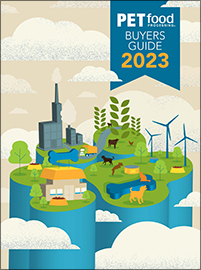GREENVILLE, SC. — In a post-COVID America, increased demand for high-quality pet food products shows no signs of slowing. Businesses in the sector have invested hundreds of millions to keep capacity growing alongside this demand. In 2023 alone, Pet Food Processing covered more than 20 new facility announcements and expansions from pet food and treat manufacturers, ingredient providers and equipment suppliers.
The combined capital expenditure value of animal food manufacturing projects announced from 2020 to 2022 exceeded $175 million, more than four-times what it was from 2017 to 2019 at $32.6 million, according to data from fDi Markets cited in Global Location Strategies’ 2024 Best Places for Food Manufacturing Insights Report for businesses in the United States. The number of these projects also significantly increased from 19 to 40, respectively, and were equally split between new locations and expansions of existing facilities.
For manufacturers looking to expand existing facilities or build greenfield plants, location is a crucial consideration. Access to partners along the supply chain, transportation and skilled labor should all factor in. And as corporate social responsibility becomes a key part of the litmus test for a good 21st century business, it can also be useful to understand how your business could impact the local community — and, in turn, what that community can offer your business.
However, in business, the bottom line is king. The reality of this makes factoring in the cost of doing business in a specific location important when choosing where to build.
“Your location investment decision will not only determine your success but will also have an indelible mark on the community, your company and your employees,” summarized Didi Caldwell, president and chief executive officer of Global Location Strategies, in the report.
Animal food manufacturing has historically flourished in the Midwestern United States, but new growth for the industry has translated to more investments from these companies in other areas of the country, such as in the Northeast.
Global Location Strategies compiled the annual report to equip business leaders and decision-makers with the knowledge needed to make such decisions with confidence. The firm leveraged several data sources to score various metro locations around the United States based on their specific operating costs, including labor costs, utilities and corporate tax rates, as well as quality factors such as workforce demographics, education, infrastructure, regulatory impact and quality of life.
Overall, Global Location Strategies ranked the South Atlantic and East South Central regions as top locations for food manufacturing, led by the following metro areas:
- Savannah, Ga.
- Hunstville, Ala.
- Bowling Green, Ky.
- Greensboro-High Point, NC
- Spartanburg, SC
- Charlotte-Concord-Gastonia, NC/SC
- Atlanta-Sandy Springs-Alpharetta, Ga.
- Lexington-Fayette, Ky.
- Knoxville, Tenn.
- Winston-Salem, NC
These locations had both above-average quality scores and below-average operating costs, according to Global Location Strategies.
East North Central region
The East North Central region, which includes Ohio, Indiana, Illinois, Michigan and Wisconsin, was home to more than one-fifth of all food manufacturing project announcements from 2020 to 2022, according to the report. The five metro locations for these operations are:
- Fort Wayne, Ind.
- Grand Rapids-Kentwood, Mich.
- Kalamazoo-Portage, Mich.
- Green Bay, Wis.
- Evansville, Ind./Ky.
Recent notable facility investments in the East North Central region included those from Nestlé Purina Petcare, which announced October 2020 a $550 million new facility project in Williamsburg, Ohio, that would add 300 jobs to the area. As well as from Blue Buffalo, which announced March 2023 it would invest $200 million in an expansion of its existing facility in Richmond, Ind., creating 55 new jobs.
West North Central
The West North Central region, which includes Iowa, Kansas, Minnesota, Missouri, Nebraska, North Dakota and South Dakota, is “one of the most attractive in the nation for food manufacturing,” according to the report. It is also home to the Animal Health Corridor, a swath of land anchored between Manhattan, Kan., and Columbia, Mo. According to the KC Animal Health Corridor, an organization advocating for the wealth of animal health opportunity in the area, this swath of land is home to 56% of global animal health, diagnostics and pet food sales.
According to Global Location Strategies, the top five metro areas in this region for food manufacturing are:
- Kansas City, Mo./Kan.
- Sioux Falls, SD
- Omaha-Council Bluffs, Neb./Iowa
- Wichita, Kan.
- Fargo, ND/Minn.
Raw pet food producer Instinct Pet Food announced a $200 million investment to expand a standing pet food manufacturing plant in Lincoln, Neb., which was expected to create nearly 330 new jobs in the area. Expansion of the LEED-certified facility was underway in September 2022.
Not mentioned in the report were recent investments from Hill’s Pet Nutrition, a subsidiary of Colgate-Palmolive, in the West North Central region. In June 2021, the company announced plans to invest at least $250 million to develop a greenfield manufacturing plant in Tonganoxie, Kan., which opened in October 2023. The “smart facility” touts strategic automation and technological advancements including AI, robotics and digital monitoring. Read more about the new facility in our exclusive processor profile here.
Also in mid-2021, Hill’s Pet Nutrition cut the ribbon at its Small Paws Innovation Center in Topeka, Kan., which was the result of a $30 million investment. Kansas has long been home to the company’s headquarters, which recently moved from Topeka to the Greater Kansas City area.
Mars Petcare’s Royal Canin division announced January 2022 it would invest $185 million into an existing pet food facility in North Sioux City, SD, creating nearly 150 new jobs in the area with help from a $3.9 million grant from the Governor’s Office of Economic Development (GOED) of South Dakota. Then, in July 2022, the Missouri Department of Economic Development shared Mars Petcare itself would invest $82 million to expand its dog and cat treat manufacturing presence in Kansas City, Mo.
The Kansas City metro area, which spans both Kansas City, Mo., and Kansas City, Kan., was ranked No. 1 in the West North Central region, and No. 11 overall in Global Location Strategies’ list of top-performing food manufacturing locations in the United States.
East South Central
This region was dubbed one of the “most attractive in the nation for food manufacturing,” according to the report. In the East South Central region, which includes Kentucky, Tennessee, Mississippi and Alabama, the top five metro areas are:
- Huntsville, Ala.
- Bowling Green, Ky.
- Lexington-Fayette, Ky.
- Knoxville, Tenn.
- Clarksville, Tenn./Ky.
In March 2021, Mars Petcare’s Royal Canin division announced it would invest $200 million to support the expansion of its pet food manufacturing facility in Lebanon, Tenn., in this region. The expansion was estimated to create 92 new jobs in the area, according to Global Location Strategies.
South Atlantic
This region is already popular for food manufacturing operations, according to the report. In the South Atlantic region, which includes Delaware, Florida, Georgia, Maryland, North Carolina, South Carolina, Virginia and West Virginia, top-performing metro areas are:
- Savannah, Ga.
- Greensboro-High Point, NC
- Spartanburg, SC
- Charlotte-Concord-Gastonia, NC/SC
- Atlanta-Sandy Springs-Alpharetta, Ga.
Nestlé Purina Petcare announced in September 2020 a $450 million investment to establish a new pet food manufacturing plant in Eden, NC, which created roughly 300 new jobs in the area. According to Global Location Strategies, the investment represents the second-largest food manufacturing announcement in the South Atlantic region since.
Northeast
The Northeast region, which includes Connecticut, Maine, Massachusetts, New Hampshire, New Jersey, New York, Pennsylvania, Rhode Island and Vermont, is known for higher-than-average costs and lower quality scores when it comes to food manufacturing real estate, according to the report. The top five metro areas in this region are:
- Allentown-Bethlehem-Easton, Pa./NJ
- Burlington-South Burlington, Vt.
- Harrisburg-Carlisle, Pa.
- Lancaster, Pa.
- Portland-South Portland, Maine
Nestlé Purina Petcare announced in the summer of 2020 it would invest $167 million in an existing pet food processing plant in Mechanicsburg, Pa., which created 94 new jobs in the area.
Allentown, Pa., garnered notable investments from two pet food manufacturers in 2022 — Breuer Premium Pet Foods, which produces the Spot & Tango brand, invested $20 million in a new warehouse in the town. Freshpet invested $61 million in a new state-of-the-art Innovation Kitchen to support its existing manufacturing campus in the surrounding area. Global Location Strategies noted that a strong industrial heritage in the Allentown-Bethlehem-Easton area has in part supported local food industry development.
West South Central
The West South Central region, which includes Arkansas, Louisiana, Oklahoma and Texas, was another low-scoring region for food manufacturing operations, according to the report. The top-performing metro areas in this region are:
- Fayetteville-Springdale-Rogers, Ark.
- Waco, Texas
- Dallas-Fort Worth-Arlington, Texas
- Oklahoma City, Okla.
- Jonesboro, Ark.
In this region, Mars Petcare and Freshpet were listed among the top 10 most notable recent investments in the area. In September 2021, Mars Petcare announced it would invest $262 million in a facility expansion in Fort Smith, Ark., which created 262 new jobs in the area and supported the company’s wet pet food manufacturing capabilities.
Freshpet announced the creation of a greenfield manufacturing campus in Ennis, Texas, in February 2020. Since that announcement, the company has invested $264 million in the project and created roughly 427 new jobs in the area, according to Global Location Strategies. The first phase of the project was completed in the fall of 2022, and the second phase is currently underway and expected to conclude in in the summer of 2024.
Northwest
While still offering some opportunities for food manufacturing businesses, the Northwest region, which includes Alaska, Idaho, Montana, Oregon, Washington and Wyoming, is not as attractive as some other US regions. Top metro areas for food manufacturing operations in this region are:
- Boise City, Idaho
- Twin Falls, Idaho
- Logan, Utah/Idaho
- Idaho Falls, Idaho
- Portland-Vancouver-Hillsboro, Ore./Wash.
The Scoular Company invested $8 million to establish an alternative protein facility in Jerome, Idaho, within the last few years. The facility produces concentrated barley protein ingredients under the moniker Emerge™ in partnership with Montana Microbial Products for use in the North American and Asian pet food and aquaculture feed markets. The companies cut the ribbon on the facility in December 2021. The project brought 13 new jobs to the area, according to Global Location Strategies.
Southwest
The Southwest region, which includes Arizona, California, Colorado, Hawaii, Nevada, New Mexico and Utah, is “one of the least attractive in the nation” for food manufacturing operations, the report stated. The top five metro areas in this region are:
- Odgen-Clearfield, Utah
- Logan, Utah/Idaho
- Provo-Orem, Utah
- Salt Lake City, Utah
- Pheonix-Mesa-Chandler, Ariz.
Global Location Strategies did not note any recent pet food industry investments in the Southwest region in its report. However, in August 2021, PetDine, a private-label pet supplement manufacturer, announced plans to invest $25 million to expand its existing facility in Windsor, Colo., which was expected to add up to 40 new jobs in the northern part of the state. The company anticipated the expansion would triple its cold-extruded soft chew and liquid supplement capabilities.
Learn more about Global Location Strategies’ 2024 Best Places for Food Manufacturing report.
Find more articles related to pet food and supplier facilities.




